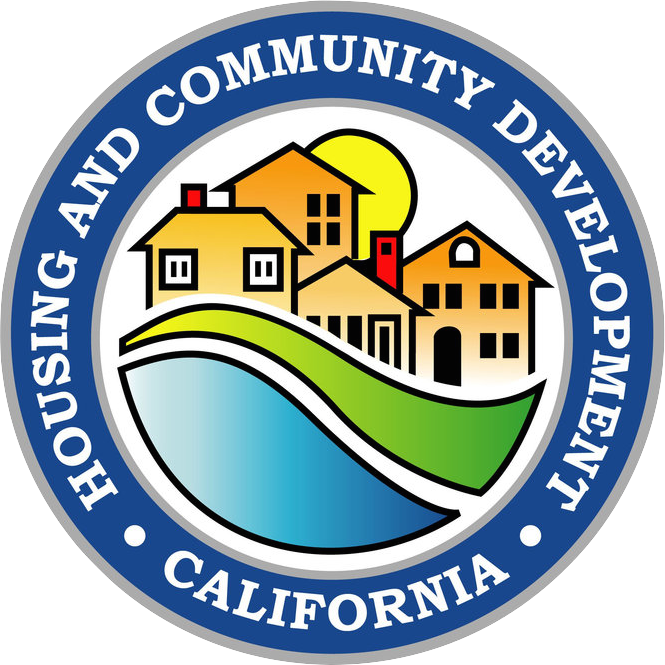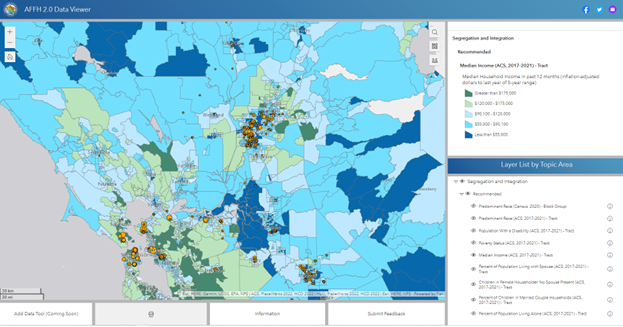Affirmatively Furthering Fair Housing
When housing choice and access are limited because of someone’s race, sexual orientation, disability status, or other protected characteristics, there are far-reaching impacts on their lives. These impacts include access to job opportunities, access to quality education, and impacts to mental and physical health.
The goal of Affirmatively Furthering Fair Housing (AFFH) is to combat housing discrimination, eliminate racial bias, undo historic patterns of segregation, and lift barriers that restrict access in order to foster inclusive communities and achieve racial equity, fair housing choice, and opportunity for all Californians.
Discriminatory government policies, exclusionary tactics, and disparate treatment have long been key components of the housing system and have which encouraged spatial inequality based on race. For decades, systemic redlining, restrictive covenants in private land sales, and residential segregation restricted many groups, particularly communities of color, from accessing opportunity and meaningful fair housing choice.
To address this, Congress established the Fair Housing Act in 1968 to prohibit discrimination in the sale, rental, and financing of housing based on race, religion, and national origin. Over time the law expanded its protections to include discrimination based on sex, disability, and familial status. The law also introduced the need to go beyond just prohibiting discrimination to instead affirmatively creating real housing choice by affirmatively furthering fair housing.
However, while federal mandates prohibited overt forms of housing discrimination, residential segregation has remained through the use of more subtle, discriminatory methods that reinforce patterns of segregation that persist in California today. AB 686 introduces strong state policy to ameliorate this issue. More background and history can be found in the introductory section of the AFFH Guidance Memo (PDF).
In 2018, the California State Legislature passed AB 686 to expand upon the fair housing requirements and protections outlined in the Fair Employment and Housing Act (FEHA). The law:
- requires all state and local public agencies to facilitate deliberate action to explicitly address, combat, and relieve disparities resulting from past patterns of segregation to foster more inclusive communities.
- creates new requirements that apply to all housing elements due for revision on or after January 1, 2021.
The passage of AB 686 protects the requirement to affirmatively further fair housing within California state law, regardless of future federal actions. It also preserves the strong policy in the U.S. Department of Housing and Community Development’s (HUD) Affirmatively Furthering Fair Housing Rule as published in the Federal Register in 2015.
As of January 1, 2019, AB 686 proactively applies the obligation to affirmatively further fair housing to all public agencies in California. Public agencies must now examine existing and future policies, plans, programs, rules, practices, and related activities and make proactive changes to promote more inclusive communities. More information on AB 686’s new obligations can be found in Part 1 of the AFFH Guidance Memo (PDF).
AB 686 creates new requirements for all housing elements due to be revised on or after January 1, 2021. These requirements ensure that the obligation to affirmatively further fair housing is a part of a jurisdiction’s planning process and guiding documents for community development. Amongst other clarifications, AB 1304 further clarified that the Housing Element analysis of AFFH required by AB 686 must include an analysis of Racially Concentrated Areas of Affluence, and that the Assessment of Fair Housing component of the Housing Element should analyze patterns and trends at both a local and regional scale.
New requirements and changes to Housing Element Law can be found in Part 2 of the AFFH Guidance Memo (PDF).
HCD released an interactive statewide AFFH Data Viewer 2.0 to assist in the assessment of fair housing. This refreshed version provides an enhanced user experience and access to the most recent fair housing data, including a series of new layers. HCD solicited feedback from advocates, councils of government, partner public agencies, and academic research groups to ensure the first iteration of the tool consolidated relevant data and provided options for addressing each component within the Assessment of Fair Housing (within the Housing Element). The AFFH Data Viewer 2.0 consists of mapped data layers in seven categories:
- Existing Affordable Housing Assets
- Racially or Ethnically Concentrated Areas
- Disparities in Access to Opportunities
- Fair Housing Enforcement and Outreach Capacity
- Segregation and Integration
- Disproportionate Housing Needs/Displacement Risk
- Supplemental Data
The interactive maps can be explored in any internet browser and exported as a PDF, jpeg, and other image files. In addition, the underlying data layers can be downloaded for offline data analysis. HCD plans to continuously update these map layers and add additional data, as well as incorporate user feedback. Comments can be submitted to AFFHGuidance@hcd.ca.gov.
To help jurisdictions meet their AB 686 obligations, HCD released the first sections of the AFFH Guidance Memo (PDF) that include:
- The duty of all public agencies to affirmatively further fair housing.
- New housing element requirements.
- Additional resources for communities.
As jurisdictions, advocates, researchers, and other partners continue to work on AFFH in their communities, HCD looks forward to soliciting additional feedback and refining this guidance. The guidance memo should be considered a living document.
Workshop and Events
The TCAC/HCD Opportunity Map identifies California regions whose characteristics have been shown by research to support positive economic, educational, and health outcomes for low-income families – particularly long-term outcomes for families with children. The map advances the AFFH objectives of increasing access to opportunity.
The TCAC/HCD Opportunity Map was created to inform statewide policy for funding affordable housing as part of the 9% Low Income Housing Tax Credit (LIHTC) program, but has since been used to inform similar policies in the other state funding programs, including the 4% Low income Housing Tax Credit (LIHTC) program and HCD's Multifamily Super NOFA.
HCD recommends that those interested in using the Opportunity Map to inform land uses policies, including the Regional Housing Need Allocation (RHNA) process, use the COG Geography TCAC/HCD Opportunity Map in the AFFH Data Viewer. This map largely uses the same methodology as the TCAC/HCD Opportunity Map, but incorporates a few changes that are better aligned with the land use context. More information can be accessed here.
TCAC and HCD release an updated version of the TCAC/HCD Opportunity Map at the end of each year, which incorporates newly available data and research and responds to stakeholder feedback. If you have questions about the map, please email affhguidance@hcd.ca.gov.
More information about the Opportunity Map can be accessed here (PDF).
Letters to Stakeholders
Each year, HCD and TCAC publish a letter to stakeholders responding to the feedback received during the most recent comment period. These letters provide additional context on the research basis that underpins the map’s methodological design, as well as documentation of methodological refinements that have been made over the years.
The most recent letters to stakeholders are below:
- Response to Comments (PDF) — 01/09/2024
- Proposed Changes (PDF) — 10/23/2023
- Response to Comments (PDF) — 01/11/2023
- Proposed Changes (PDF) — 12/08/2022
- Response to Comments (PDF) — 12/01/2021
- Proposed Changes (PDF) — 10/15/2021
- Response to Comment (PDF) — 12/07/2020
- Proposed Changes (PDF) — 10/21/2020
- Response to Comments (PDF) — 06/05/2020
- Proposed Changes (PDF) — 04/24/2020
- Proposed Changes (PDF) — 09/26/2018
- Response to Comments (PDF) — 11/17/2017
- Memo (PDF) — 08/08/2017
HCD developed the Neighborhood Change Map to support affordable housing funding policies to reduce displacement in gentrifying areas. The Neighborhood Change Map identifies census tracts (excluding rural tracts) that have experienced both substantial racial/ethnic change and economic change, and exhibit markers of disproportionate housing need. This map advances the AFFH objective of addressing disproportionate housing need, including displacement.
More information on the Neighborhood Change Map can be found here:
Through the Opportunity Framework project, HCD is assessing and refining the state’s approach to Affirmatively Furthering Fair Housing (AFFH) across different types of neighborhoods and multiple policy areas. The Opportunity Framework project recognizes the state’s obligation to develop a comprehensive strategy for furthering each of the following AFFH objectives:
- Addressing significant disparities in housing needs
- Addressing significant disparities in opportunity access
- Replacing segregated living patterns with truly integrated living patterns
- Transforming racially and ethnically concentrated areas of poverty in areas of opportunity
- Fostering compliance with fair housing laws
Through the Opportunity Framework project, HCD is looking to identify areas where existing AFFH policies can be refined, where new policies or programs may be needed, and where HCD can better collaborate with other state entities to affirmatively furthering fair housing. HCD will also identity and create additional tools needed to support the state’s AFFH efforts.
To kick-off this project, HCD hosted a virtual webinar on June 7, 2023. The PowerPoint slides from this Webinar can be accessed here. HCD also launched a public survey to collect feedback on the state's AFFH approach, which closed July 21, 2023.
In response initial stakeholder feedback, HCD developed a new Neighborhood Change Map to support affordable housing funding policies to reduce displacement in gentrifying areas. Additional policy proposals that emerged out of this process will be released over the coming months. If you would like to learn more about this work, you can email affhguidance@hcd.ca.gov to indicate your interest.
HCD is currently working on an update to the Final 2020 AI. Below are links to the Community Assessment Needs Survey, webinar recordings, planned listening sessions, and planned webinars. Any additional information will be added as it becomes available.
- Community Assessment Needs Survey
- Analysis of Impediments to Fair Housing Choice Kickoff Webinar
- Homelessness Listening Session — 1/31/2024 Recording
- Disabilities & Aging Population Listening Session – 2/7/2024 Recording — Coming Soon!
- Disabilities & Aging Population Listening Session Slides (PDF) — Coming Soon!
- Persons Who are Immigrants Listening Session – 2/14/2024 Recording — Coming Soon!
- Persons Who are Immigrants Listening Session Slides (PDF) — Coming Soon!
- Tribal Listening Session – 2/21/2024 Recording — Coming Soon!
- Tribal Listening Session Slides (PDF) — Coming Soon!
- Register Now: Mobilehome Parks Listening Session — 3/5/2024, 10:30 AM - 12:00 PM
- Register Now: Urban Communities Webinar — 3/13/2024, 1:00 PM – 2:30 PM
- Register Now: Rural Communities Webinar — 3/20/2024, 1:30 PM – 3:00 PM


